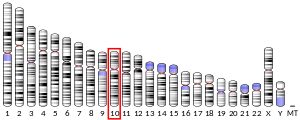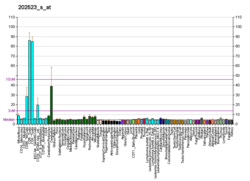SPOCK2
Testican-2 is a protein that in humans is encoded by the SPOCK2 gene.[5][6]
Function
Proteoglycans, which consist of a core protein and covalently linked glycosaminoglycans, are components of the extracellular matrix. SPOCK2 encodes a member of a novel Ca(2+)-binding proteoglycan family.[supplied by OMIM][6]
gollark: PotatOS Fast Reboot™ just reruns the entire init system, but does *not* bother killing processes.
gollark: Ale: As I said, it still stores the `isRunning` thing.
gollark: No clue.
gollark: PotatOS Fast Reboot doesn't reload the actual node library, so I have to reset that using debug.setupvalue.
gollark: There's an `isRunning` flag so that `node.init` only runs once.
References
- GRCh38: Ensembl release 89: ENSG00000107742 - Ensembl, May 2017
- GRCm38: Ensembl release 89: ENSMUSG00000058297 - Ensembl, May 2017
- "Human PubMed Reference:". National Center for Biotechnology Information, U.S. National Library of Medicine.
- "Mouse PubMed Reference:". National Center for Biotechnology Information, U.S. National Library of Medicine.
- Vannahme C, Schübel S, Herud M, Gösling S, Hülsmann H, Paulsson M, Hartmann U, Maurer P (July 1999). "Molecular cloning of testican-2: defining a novel calcium-binding proteoglycan family expressed in brain". Journal of Neurochemistry. 73 (1): 12–20. doi:10.1046/j.1471-4159.1999.0730012.x. PMID 10386950.
- "Entrez Gene: SPOCK2 sparc/osteonectin, cwcv and kazal-like domains proteoglycan (testican) 2".
Further reading
- Nagase T, Seki N, Ishikawa K, Ohira M, Kawarabayasi Y, Ohara O, Tanaka A, Kotani H, Miyajima N, Nomura N (October 1996). "Prediction of the coding sequences of unidentified human genes. VI. The coding sequences of 80 new genes (KIAA0201-KIAA0280) deduced by analysis of cDNA clones from cell line KG-1 and brain". DNA Research. 3 (5): 321–9, 341–54. doi:10.1093/dnares/3.5.321. PMID 9039502.
- Nakayama M, Kikuno R, Ohara O (November 2002). "Protein-protein interactions between large proteins: two-hybrid screening using a functionally classified library composed of long cDNAs". Genome Research. 12 (11): 1773–84. doi:10.1101/gr.406902. PMC 187542. PMID 12421765.
- Nakada M, Miyamori H, Yamashita J, Sato H (June 2003). "Testican 2 abrogates inhibition of membrane-type matrix metalloproteinases by other testican family proteins". Cancer Research. 63 (12): 3364–9. PMID 12810672.
- Clark HF, Gurney AL, Abaya E, Baker K, Baldwin D, Brush J, Chen J, Chow B, Chui C, Crowley C, Currell B, Deuel B, Dowd P, Eaton D, Foster J, Grimaldi C, Gu Q, Hass PE, Heldens S, Huang A, Kim HS, Klimowski L, Jin Y, Johnson S, Lee J, Lewis L, Liao D, Mark M, Robbie E, Sanchez C, Schoenfeld J, Seshagiri S, Simmons L, Singh J, Smith V, Stinson J, Vagts A, Vandlen R, Watanabe C, Wieand D, Woods K, Xie MH, Yansura D, Yi S, Yu G, Yuan J, Zhang M, Zhang Z, Goddard A, Wood WI, Godowski P, Gray A (October 2003). "The secreted protein discovery initiative (SPDI), a large-scale effort to identify novel human secreted and transmembrane proteins: a bioinformatics assessment". Genome Research. 13 (10): 2265–70. doi:10.1101/gr.1293003. PMC 403697. PMID 12975309.
- Zhang Z, Henzel WJ (October 2004). "Signal peptide prediction based on analysis of experimentally verified cleavage sites". Protein Science. 13 (10): 2819–24. doi:10.1110/ps.04682504. PMC 2286551. PMID 15340161.
- Olsen JV, Blagoev B, Gnad F, Macek B, Kumar C, Mortensen P, Mann M (November 2006). "Global, in vivo, and site-specific phosphorylation dynamics in signaling networks". Cell. 127 (3): 635–48. doi:10.1016/j.cell.2006.09.026. PMID 17081983.
This article is issued from Wikipedia. The text is licensed under Creative Commons - Attribution - Sharealike. Additional terms may apply for the media files.





